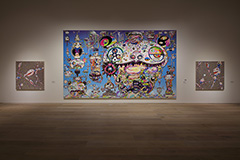Highlights
727, Ensō (circle) and Abstraction | Daruma | Mr. DOB | The 500 Arhats – "Blue Dragon" and "White Tiger" | The 500 Arhats – "Black Tortoise" and "Vermilion Bird"
Mr. DOB

Installation view: "Takashi Murakami: The 500 Arhats," Mori Art Museum, Tokyo, 2015 Photo: Takayama Kozo
(C)2015 Takashi Murakami/Kaikai Kiki Co., Ltd. All Rights Reserved.
Mr. DOB, a cartoon character elevated to the level of contemporary art subject, was born in 1993 with the aim of disjointing the meaning of Japanese "character culture," a subject that had suddenly become the focus of attention at the time. His form drew on elements of a character called Pyonkichi from the manga Dokonjo Gaeru (Gutsy Frog) and the video game character Sonic the Hedgehog, while his name is a contraction of the Romanized spelling of a coinage created through the meaningless combination of comedian Yuri Toru's catchphrase, "oshamanbe," and the line "dobojite dobojite" (Why? Why?) from the manga Inakappe Taishō.
In other words, the name "DOB" itself has no meaning. This thought, which dates back to the title of his doctoral thesis, "Imi no muimi no imi" (The meaning of the nonsense of the meaning), also serves as both the motivation and the very subject of Murakami's artistic practice via his unique brand of nihilism and cynicism. The design of Mr. DOB has been morphing in detail and proliferating ever since, the character becoming an alter ego or self-portrait-like presence that joins/infiltrates diverse contexts and traverses various boundaries.
Tan Tan Bo, in a sense a reincarnation of Mr. DOB as a monster, is based on a manga character created by Mizuki Shigeru, a favorite of Murakami's when he was a boy, in the form of a phantom consisting solely of a giant face spitting out phlegm from its mouth. The complex image of the phantom reflects Murakami's personal anxiety regarding the expanding development of nuclear power. At one extreme of Murakami self-portraits is Gero Tan. Gero Tan, who appears to writhe while vomiting, was born when Murakami conflated the character of Tan Tan Bo with his own wretched sense of cracking under pressure at a time when his career first expanded to the international arena. These paintings employ a complex "cruciform composition" that references the work of Itō Jakuchu and a technique that generates spatial expansiveness through the movement of the viewer’s gaze. These elements, in combination with the characters' expressions, aim to create a story within the canvas.
727, Ensō (circle) and Abstraction | Daruma | Mr. DOB | The 500 Arhats – "Blue Dragon" and "White Tiger" | The 500 Arhats – "Black Tortoise" and "Vermilion Bird"
Copyright (C) Mori Art Museum, The Asahi Shimbun, NHK Promotions Inc. 2015-2016 All Rights Reserved.